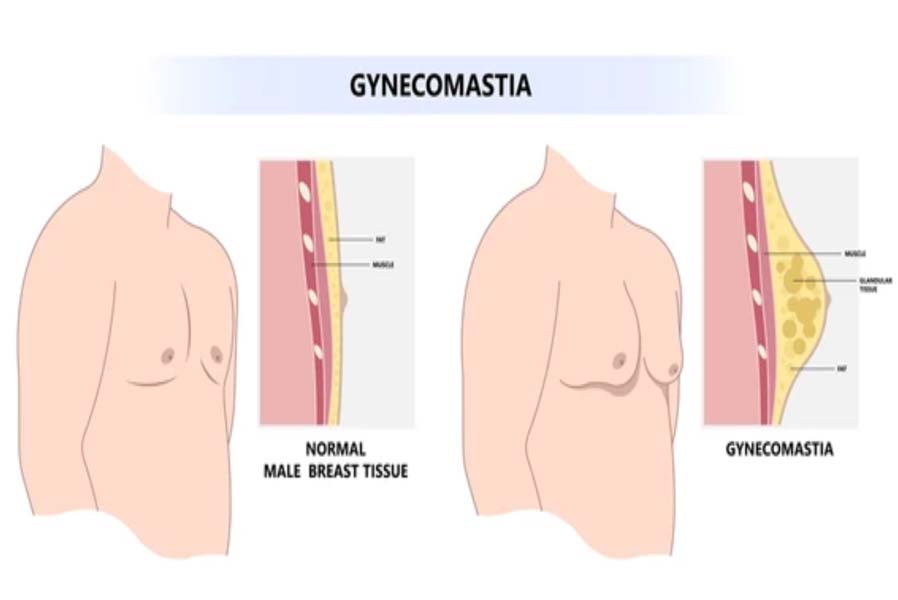
Gynaecomastia Doctor in Jaipur
Gynaecomastia is a medical condition characterized by the enlargement of breast tissue in males. It is commonly referred to as "man boobs" or "moobs." While it may cause embarrassment or self-consciousness, gynaecomastia is typically benign and does not pose a serious health risk. However, it can affect self-esteem and quality of life for those affected.
The diagnosis of gynaecomastia is typically based on physical examination, medical history, and sometimes imaging studies (such as ultrasound or mammography) to rule out other potential causes, such as breast cancer. Treatment options depend on the underlying cause and severity of gynaecomastia. In many cases, observation and reassurance may be sufficient, especially if gynaecomastia is expected to resolve on its own (such as during puberty).
It's important for individuals experiencing gynaecomastia to consult with Dr. Naincy Purwar to determine the underlying cause and appropriate management plan tailored to their specific situation. In some cases, both an endocrinologist and a plastic surgeon may be involved in the care of individuals with gynaecomastia. For example, if hormonal imbalances are contributing to the gynaecomastia, an endocrinologist may work with the patient to address these underlying issues before or after surgical intervention by the plastic surgeon.
The treatment of gynaecomastia depends on the underlying cause, severity of the condition, and the presence of any associated symptoms or distress. Dr. Naincy Purwar can conduct a thorough evaluation, assess potential underlying causes, and recommend a treatment plan tailored to your needs and preferences.
Endocrinologist Dr. Naincy Purwar is specialize in diagnosing and treating hormonal imbalances and disorders. Since hormonal imbalances can be a common underlying cause of gynaecomastia, Dr. Naincy Purwar can perform a thorough evaluation to determine if there are any hormonal abnormalities contributing to the condition. She may order blood tests to assess hormone levels and may recommend treatments to address any identified hormonal imbalances. If the gynaecomastia is related to a specific medical condition, such as a hormone-secreting tumor, Dr. Naincy can coordinate further management or referral to other specialists as needed.
Gynaecomastia can most commonly observed during three periods of life:
- Newborns: It is not uncommon for male infants to have temporary gynaecomastia due to exposure to maternal hormones during pregnancy. This usually resolves within a few weeks after birth without treatment.
- Puberty: Gynaecomastia often occurs during puberty due to hormonal changes. Fluctuations in hormone levels, specifically an increase in estrogen relative to testosterone, can lead to the development of breast tissue in boys. This usually resolves on its own within a couple of years as hormone levels stabilize.
- Adulthood: Gynaecomastia can also occur in adult males. It may be associated with hormonal imbalances, certain medical conditions, medications, or lifestyle factors. Common causes include hormonal changes related to aging, obesity, liver disease, thyroid disorders, use of certain medications (such as anabolic steroids, antiandrogens, and some antidepressants), and use of illicit drugs like marijuana.
Treatment of gynaecomastia options may include:
- Lifestyle Modifications: In cases where gynaecomastia is associated with factors such as obesity or use of certain medications or substances, lifestyle changes may be recommended to address underlying causes.
- Medications: In some cases, medications such as selective estrogen receptor modulators (e.g., tamoxifen) or aromatase inhibitors (e.g., anastrozole) may be prescribed to reduce breast tissue growth and size.
- Surgery: Surgical removal of excess breast tissue (mastectomy) may be considered for individuals with persistent or severe gynaecomastia that does not respond to other treatments.
Here are some common treatment options:
- Observation and Lifestyle Changes: In cases where gynaecomastia is mild and not causing significant distress, your doctor may recommend observation and lifestyle modifications. This might include weight loss (if obesity is a contributing factor), avoiding drugs or medications known to cause gynaecomastia, and minimizing alcohol consumption.
- Medications: In some cases, medications may be prescribed to treat gynaecomastia, especially if it's caused by hormonal imbalances. Selective estrogen receptor modulators (SERMs) like tamoxifen or raloxifene may be used to block the effects of estrogen on breast tissue and reduce breast size. Aromatase inhibitors, such as anastrozole or letrozole, may also be prescribed to inhibit the conversion of androgens to estrogen.
- Surgery (Mastectomy): Surgical removal of the excess breast tissue (mastectomy) is often recommended for individuals with persistent or severe gynaecomastia. This procedure can be performed by a plastic surgeon and may involve liposuction, excision of glandular tissue, or a combination of both techniques. Surgery is typically reserved for cases where other treatments have been ineffective, and the gynaecomastia is causing significant psychological or physical discomfort.
- Treatment of Underlying Conditions: If gynaecomastia is secondary to an underlying medical condition or medication, treating the underlying cause may help resolve the breast enlargement. For example, if gynaecomastia is caused by a hormone-secreting tumor or anabolic steroid use, addressing these issues may lead to improvement.
- Psychological Support: Gynaecomastia can have a significant impact on self-esteem and body image, particularly in adolescents. Psychological support and counseling may be beneficial for individuals experiencing distress related to gynaecomastia. This can help them cope with feelings of embarrassment or anxiety and improve overall well-being.
Want to consult about Gynaecomastia treatment:
Call now : Dr. NAINCY PURWAR
+91-7297080208


